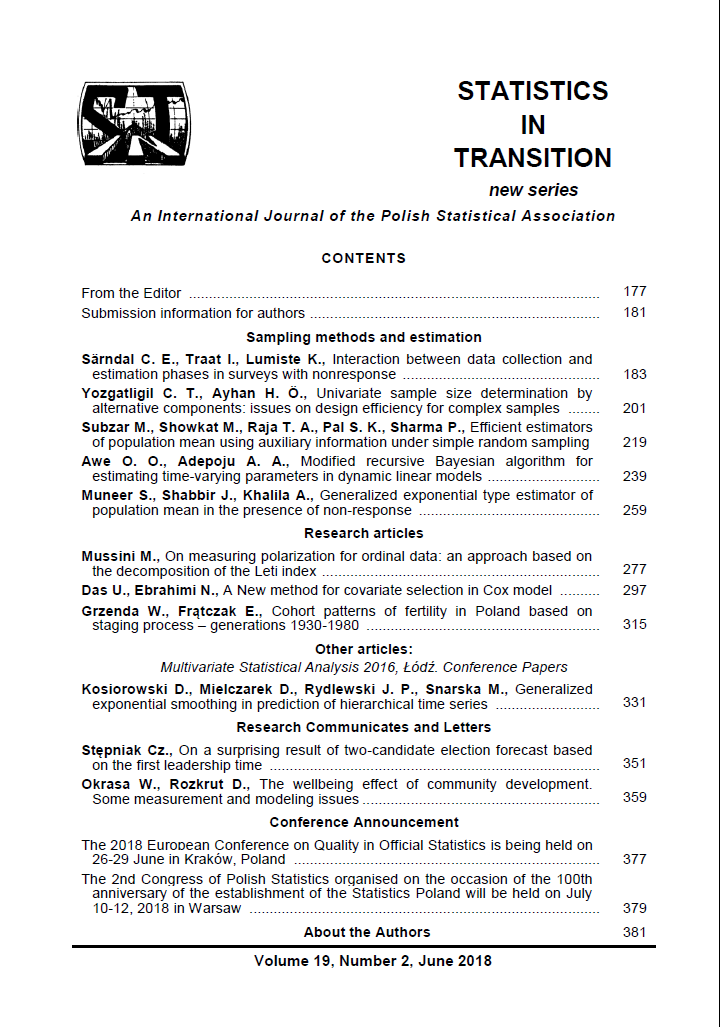ARTICLE
ABSTRACT
In a wide spectrum of natural and social sciences, very often one encounters a large number of predictors for time to event data. An important task is to select right ones, and thereafter carry out the analysis. The l1 penalized regression, known as “least absolute shrinkage and selection operator" (LASSO) became a popular approach for predictor selection in last two decades. The LASSO regression involves a penalizing parameter (commonly denoted by λ) which controls the extent of penalty and hence plays a crucial role in identifying the right covariates. In this paper we propose an information theory-based method to determine the value of λ in association with the Cox proportional hazards model. Furthermore, an efficient algorithm is discussed in the same context. We demonstrate the usefulness of our method through an extensive simulation study. We compare the performance of our proposal with existing methods. Finally, the proposed method and the algorithm are illustrated using a real data set.
KEYWORDS
Bhattacharya distance, index of resolvability, Kullback-Leibler measure, l1 penalty, proportional hazards model, time to event data.
REFERENCES
BARRON, A. R., COHEN, A., DAHMEN, W., DEVORE, R., (2008). Approximations and learning by greedy algorithms, The Annals of Statistics. 36, pp. 64–94.
BARRON, A. R., HUANG, C., LI, J. Q., LUO, X., (2008a). The MDL principle,penalized likelihoods, and statistical risk, In Festschrift for Jorma Rissanen, Tampere University Press.
BARRON, A. R., LUO, X., (2008). MDL Procedures with `1 Penalty and their Statistical Risk, Proceedings Workshop on Information Theoretic Methods in Science and Engineering.
BENDER, R., AUGUSTIN, T., BLETTNER, M., (2005). Generating survival Times to simulate Cox proportional hazards models, Statistics in Medicine, 24 (11), pp. 1713–1723.
BHATTACHARYA, A., (1943). On a measure of divergence between two statistical populations defined by probability distributions, Bulletin of Calcutta Mathemat ical Society. 35, pp. 99–109.
BREIMAN, L., (1996). Heuristics of instability and stabilization in model selection, The Annals of Statistics. 24, pp. 2350–2383.
COX, D. R., (1972). Regression models and life tables (with discussions), Journal of Royal Statistical Society, Series B. 34, pp. 187–220.
DAS, U., EBRAHIMI, N., (2017). Covariate selection for accelerated failure time data, Communications in Statistics: Theory and Methods. 46, pp. 4051–64.
EBRAHIMI, N., SOOFI, E. S., SOYER, R., (2010). Information measures in per spective, International Statistical Review. 78, pp. 383–412.
FAN, J.„ LI, R., (2001). Variable selection via nonconcave penalized likelihood and its oracle properties, Journal of American Statistical Association. 456, pp. 1348-1360.
GRUNWALD, P., (2007). The minimum description length principle. MIT Press, Cambridge, MA.
KULLBACK, S., (1959). Information theory and Statistics. Wiley, New York; (reprinted in 1968 by Dover).
LENG, C., LIN, Y., WAHBA, G., (2006). A note on the lasso and related procedures in model selection, Statistica Sinica, 16, pp. 1273–1284. LI, J. Q., BARRON, A. R., (2000). Mixture density estimation, S Solla, T Leen andK.R. Muller ( Eds.), Advances in Neural Processing Information System, 12, pp. 279–285.
LOPRINZI, C. L., LAURIE, J. A., WIEAND, H. S., KROOK, J. E., NOVOTNY, P. J.,
KUGLER, J. W., BARTEL, J., LAW, M., BATEMAN, M., KLATT, N. E. et al., (1994). Prospective evaluation of prognostic variables from patient-completed questionnaires. North Central Cancer Treatment Group. Journal of Clinical Oncology, 12 (3), pp. 601–607.
LUO, X., (2009). Penalized Likelihoods: Fast algorithms and risk bounds, Ph.D. Thesis, Statistics Department, Yale University.
ROSSI, P. H., BERK, R. A., LENIHAN., K. J., (1980). Money, Work and Crime: Some Experimental Results. New York: Academic Press.
SHANNON, C. E., (1948). A mathematical theory of communication, Bell Sys. Tech. J.. 27, pp. 379–423.
SIMON, N., FRIEDMAN, J., HASTIE, T., TIBSHIRANI, R., (2011). Regularization paths for Cox’s proportional hazards model via coordinate descent, Journal of Statistical Software, 39 (5), pp. 1–13.
Tibshirani, R., (1996). Regression shrinkage and selection via the lasso, Journal of the Royal Statistical Society, Series B, 58, pp. 267–288.
Tibshirani, R., (1997). The lasso method for variable selection in the Cox model, Statistics in Medicine, 16, pp. 385–395.
